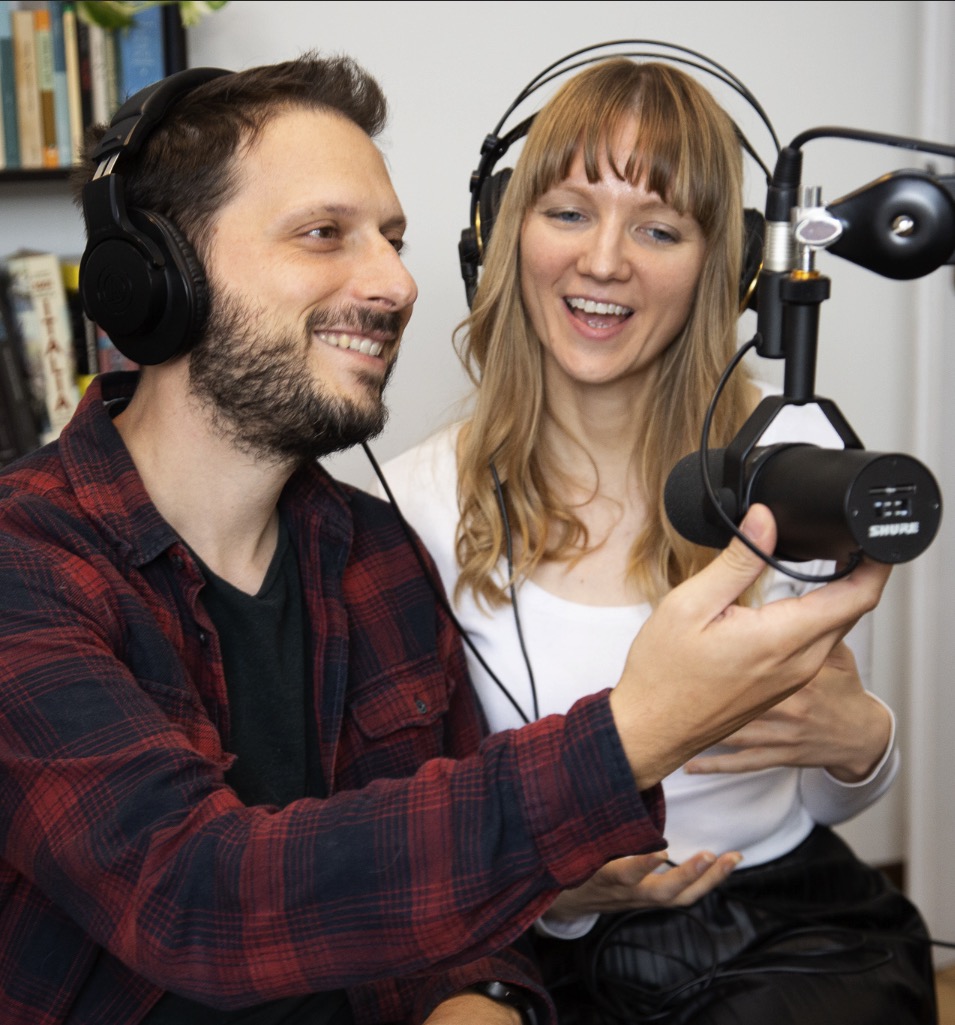Do you have hopes and dreams of speaking a language fluently, but you’re too lazy to study?
Me too.
But what if I told you that your laziness, far from being a limitation, could actually make you great at learning languages?
Read on (if you can be bothered) to find out why the lazy way is often the best way, and learn 7 ways you can leverage your laziness to learn a language effectively at home.
Lazy people find better ways to do things
If you were a builder at the end of the 19th century, life was hard.
Long hours. Crappy pay. Little regard for health and safety. If you were really unlucky, it could even cost you your life: 5 men died during the construction of the Empire State Building and 27 died working on the Brooklyn bridge.
Occupational hazard: In the late 19th century, being a builder was a strenuous job with a high mortality rate.What qualities did builders need to be the best at such a demanding and dangerous job? Tenacity? Diligence? Stamina? Nope.
In 1868, a young construction worker named Frank Gilbreth began observing colleagues in order to understand why some bricklayers were more effective than others, when he made a surprising discovery.
The best builders weren’t those who tried the hardest. The men Gilbreth learnt the most from, were the lazy ones. Laying bricks requires repeating the same movements over and over again: the fewer motions, the better.
In an attempt to conserve energy, the “lazy” builders had found ways to lay bricks with a minimum number of motions. In short, they’d found more effective ways to get the job done.
But what do lazy bricklayers have to do with language learning?
Well, inspired by his lazy colleagues, Gilbreth went on to pioneer “motion study”, a technique which streamlines work systems and is still used today in many fields to increase productivity.
You know that person in operating theaters who passes scalpels to the surgeon and wipes their brow? Gilbreth came up with that idea. Hiring someone to pass you things from 20 centimeters away and wipe the sweat off your own forehead?
It doesn’t get much lazier than that. Yet it helps surgeons work more efficiently and probably saves lives in the process. The bottom line? The lazy way is usually the smartest way.
Over the years, Gilbreth’s ideas have been attributed to Bill Gates (which, although factually incorrect, makes a nicer motivational poster to hang in your office).
How to learn a language at home (even if you’re really lazy)
If your school was anything like mine, you may have some experience learning languages with the “try harder” approach.
Page after page of grammar exercises, long vocabulary lists, listening exercises about stationary or some other excruciatingly boring topic.
And if you still can’t speak the language after all that effort? Well, you should try harder.
But what if there's a better way to learn a language?
A lazier way, that you can use to learn a language at home, with less effort? A way to learn by doing things you actually enjoy? A way to learn by having a laugh with native speakers? A way to learn without taking your pajamas off ?
There is.
Don’t get me wrong, languages take time and effort , there’s no getting around that. This isn’t about being idle. It’s about finding effective ways to learn, so you can stop wasting time and energy on stuff that doesn’t work.
To help you find them, I’ve put together a list of 7 lazy (but highly effective) ways to learn a language at home.
They'll help you:
⁃ Speak a language better by studying less.
⁃ Go against “traditional” language learning methods to get better results.
⁃ Get fluent in a language while sitting around in your undies and drinking beer
Lazy way to learn a language at home #1: Don’t study (much)
A lot of people try to learn a language by “studying”.
They try really hard to memorise grammar rules and vocabulary in the hope that one day, all the pieces will come together and they'll magically start speaking the language. Sorry, but languages don’t work that way.
Trying to speak a language by doing grammar exercises is like trying to make bread by reading cookbooks. Sure, you’ll pick up some tips, but you’ll never learn how to bake unless you’re willing to get your hands dirty.
Languages are a learn by doing kind of thing. The best way to learn to speak, understand, read and write a language is by practicing speaking, listening, reading and writing.
That doesn’t mean you should never study grammar or vocabulary. It helps to get an idea of how the language works. But if you dedicate a disproportionate amount of time to that stuff, it’ll hold you back. You’ll learn much faster by using the language.
Now, if you’re a total newbie, you may be wondering how you can start using a language you don’t know yet. If you’re learning completely from scratch, a good textbook can help you pick up the basics. But avoid ones which teach lots of grammar rules without showing you how to use them in real life.
The best textbooks are the ones which give you lots of example conversations and introduce grammar in bitesized pieces, like Assimil.
As soon as you can, aim to get lots of exposure to the language being used in a real way. If you’re a lower level, you can start by reading books which have been simplified for your level (called graded readers). Look for ones accompanied with audio so you can work on your listening at the same time.
Another great way is to listen to podcasts with simplified, slowed down speech and transcripts such as Slow German , Slow Chinese , the News in Slow Podcasts or the Coffee Break Series .
Duolingo has also just added a fab new beta feature called stories : fun simple tales for learners with interactive translations and mini comprehension quizzes. For the moment, it’s only in Spanish and Portuguese, but keep an eye out for other languages coming soon.
Lazy way to learn a language at home #2: Sit around in your undies
Next, you’ll need to practice speaking. Luckily, you can now do this on Skype, so you only need to get dressed from the waist up.
The best place for online conversation classes is italki .
Here, you can book 1-to-1 conversation lessons with lovely native speaker tutors – called community tutors – for less than $10 an hour.
If you fancy giving it a go, you can get a $10 voucher after you book your first lesson here: Click here to find a tutor on italki and get $10 off.
When you buy through this link, I also get $10 off my language lessons on italki, which helps me save money and write articles like the one you're reading now, gracias!
If you like the idea, but you're not sure where to start, check out this post: italki: how to learn a language with an online tutor.
Alternatively, if you prefer a free option, you can also use italki to find people who are learning your native language and set up a language exchange. One risk with language exchanges is that English becomes the default language and they end up using your time to practice their English.
To make it work, be sure to set a clear boundary for when each language is spoken (e.g. say 30 minutes in English and 30 minutes in Spanish) and be strict about sticking to it.
Or, if you’re feeling brave enough to put some pants on, you can find a flesh-and-blood language exchange partner who lives near you via conversation exchange or Tandem .
You can even arrange to meet up at the pub and combine my two great loves: languages and beer. Importantly, make it a priority to find conversation tutors and language exchange partners you actually enjoy spending time with.
It can be real chore to sit down and chat 1-on-1 for 60 minutes with someone you don’t click with. But once you find people you get on well with, it's easy to motivate yourself to practice speaking.
Lazy way to learn a language at home #3: Don’t try too hard
Getting out of your comfort zone is brilliant, it’s where the learning happens.
But you don’t feel like you have to venture too far. If you're frustrated by the speed of the listening, too many new words, or tricky grammar, it’s probably a sign that you’ve gone too far. Pushing yourself too hard isn’t a good way to learn, for a number of reasons:
1. When there’s too much new information, it’s difficult to take any of it in.
2. When you’re stressed, your mind’s less receptive to learning.
3. If you have to constantly stop and look up new words, it gets very boring very quickly.
4. It’s difficult to sustain that kind of effort long term (consistency is essential to language learning).
5. Being frustrated isn’t fun, so you’re more likely to give up. Aim for the sweet spot just above your current level, where you’re coming across new words, but you can still get the general gist of what’s being said.
For more tips on getting the level right, check out this post: the 11 easiest languages to learn (and how to make any language easy)
Lazy way to learn a language at home #4: Don’t waste time learning pointless stuff
Smart lazy language learners know they can’t learn everything at once, so they prioritise words and phrases they’ll get the most mileage out of.
The exact words and phrases will depend on the language you’re learning and the situations you’re likely to find yourself in, but as a general rule, frequent conversation phrases like “I’d like”, “maybe” or “I think so” are more useful than things like “rooms in my house” or “items in my pencil case”.
Lazy way to learn a language at home #5: Don't rely on willpower.
If you’ve tried to learn a language and failed in the past, you might think it’s because you don’t have enough willpower. It’s true, you don’t. But neither does anyone else.
That’s why most people who try to learn a language (or do anything similar, like losing weight or learning to play an instrument) start out enthusiastically, only to run out of steam a few weeks later. Look closer at the people who’ve succeeded in learning a language and you’ll see that they’re the ones who’ve managed to build a habit.
Once you get into the habit of learning a language , you don’t have to struggle so much to find the time or the energy. You just do it. What’s the best way to get into the language habit? The lazy way of course!
We have a natural tendency to resist change, which is why big efforts don’t usually last. The key is to make changes so small, they’re almost imperceptible. Start with teeny goal, like learning a language for 5 minutes, then increase it in small increments, like 1 minute each day. By the end of one month, you’ll be up to 30 minutes per day and well on your way to learning that language.
Lazy way to learn a language at home #6: Do stuff you enjoy
Who are the laziest people alive?
Stoners of course.
At university, I knew a guy who was so lazy he wore the same clothes every day and ate pasta straight out of the pan so he didn’t have to wash a plate. Yet when it came to his favorite occupation, smoking weed, he’d go to extreme lengths to get the right kind at the right price and happily walk all the way to the other side of town to pick it up.
Laziness is relative: most people have plenty of energy for things they enjoy doing. When you actually want to do something, be that getting stoned, eating cheese or watching disney films in a foreign language, it’s not hard to get started.
Even stoners can motivate themselves to do things they enjoy.The key is to find ways to learn a language at home that you like, so you don’t have to fight with yourself so much.
The best way to do this is to get into the habit of reading, watching and listening to things you like in the language you’re learning: audiobooks, YouTube, Netflix, newspapers, soap operas, hiphop, disney films, documentaries, novels, reality tv, cookery programmes, fashion blogs, sports papers, world of warcraft…whatever does it for you.
The closer it is to things you enjoy doing in your native language, the better. Or, it you’re a lower level and those kind of resources are too tricky to follow, start with fun things aimed at language learners like podcasts, YouTube tutorials, graded readers or duolingo stories .
YouTube is a brilliant place for language learners as there are often subtitles. To make the most out of subtitles for language learning, read the ones in the language you’re learning, and only use the English ones to check your understanding.
You can also use YouTube to slow down the speed, which helps you focus on the details of what they’re saying (as well as making the speaker sound like they’ve knocked back a few tequilas before going on camera).
Go home YouTube, you’re drunk. YouTube is great for language learning as you can slow down the speech in the settings menu to understand what’s being said. It also makes the speaker sound like they’ve had a few too many.A super tool for reading online is the google translate chrome add on .
It turns any website into an interactive dictionary, so you can click on a word you don’t know and get the translation in your native language. This makes it very easy to read websites in the language you’re learning without interrupting your flow to look up new words all the time.
To find some sites you like, do a quick google search with the language you’re learning + the genre you’re after (e.g. Spanish Newspapers or French fashion blogs) and you should find a nice list. Alternatively, if you’re feeling lazy, buzzfeed in your target language is a good place to start.
With the google translate chrome add on, you can turn any webpage into an interactive dictionary.For more inspiration on enjoyable ways to learn a language, check out this list: 32 fun ways to learn a language (that actually work).
Lazy way to learn a language at home #7: Change your surroundings
Lazy language learners know that if they have to rely on their own initiative to learn a language, it probably won’t get done. Smart lazy language learners get round this by making changes to their environment so they’re interacting with the language all day, in a way that doesn’t require a lot of extra effort.
Here are a few sneaky ways you can integrate language learning into your surroundings:
• Change the language on Facebook/Twitter/your phone to your target language (but remember how to change it back!)
• Change your homepage to a website in your target language.
• Get some headphones and listen to the language as much as you can: on the way to work, cooking, cleaning the toilet…
• Talk to your yourself (or your pets) in the language you’re learning.
Remember, language learning doesn’t happen through big, sporadic efforts. It’s all in the details. Take some time to think of small ways you could integrate your target language into your daily life.
And most importantly, actually do it. These small actions, when repeated daily, will add up to big results.
Quick guide: how to learn a language at home (the lazy way)
| #1: Don’t study (much) | Grammar is useful, but don’t make it your main focus. Try to get as much exposure as possible to the language being used in real way by reading and listening. |
| #2: Practice speaking as much as you can | Book conversation lessons on Skype, or arrange conversation exchanges. Make a point of finding conversation partners you enjoy spending time with. |
| #3: Don’t try too hard | Aim for the sweet spot just above your level, where you come across new words but you can get the gist of what’s being said. |
| #4: Don’t waste time on pointless stuff | Common conversation phrases like “I don’t know” or “I think so” are more useful than things like “rooms in my house” or “things in my pencil case” |
| #5: Build habits | Don’t rely on willpower. Get into the language learning habit by starting with 5 minutes a day and gradually increasing the time. |
| #6: Do stuff you enjoy | Make a point of finding things to read or listen to that you enjoy. The closer it is to things you like doing in your native language, the better. |
| #7: Change your surroundings | Find sneaky ways to integrate language learning into your daily life, by changing the language of your Facebook, or listening to podcasts on your way to work. |
What do you think?
Are you learning a language at home? Do you think the lazy way could work for you? Which one of these 7 tips could you start doing right now to help you learn a language?




